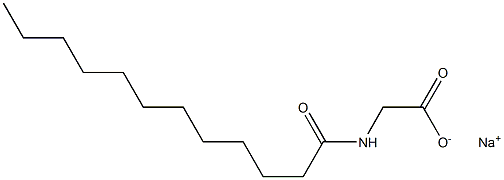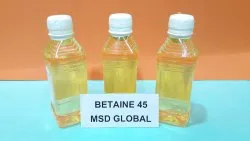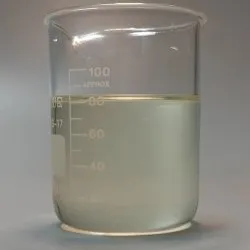Cocamidopropyl betaine
- CAS NO.:86438-79-1
- Empirical Formula: C19H38N2O3
- Molecular Weight: 342.52
- MDL number: MFCD04113348
- EINECS: 203-490-6
- SAFETY DATA SHEET (SDS)
- Update Date: 2025-12-17 09:50:42
What is Cocamidopropyl betaine?
Description
Cocamidopropyl betaine is an important zwitterionic surfactant, with a mild detergent action that is also more viscous than the other types of surfactant.
Chemical properties
Cocamidopropyl Betaine (CAB) is an organic compound derived from coconut oil and dimethylaminopropylamine. It is a zwitterion, consisting of both a quaternary ammonium cation and a carboxylate. CAB is available as viscous pale yellow solution that is used as a surfactant in personal care products.
The Uses of Cocamidopropyl betaine
cocamidopropyl betaine is a surfactant derived from a coconut oil salt. It is particularly effective in shampoos, foam baths, shower foams, and other preparations where high, creamy foam and good skin tolerance are desired.
The Uses of Cocamidopropyl betaine
Cocamidopropyl betaine is an amphoteric surfactant, which enjoys increasing popularity among cosmetic chemists because of its low potential for irritation of the skin. It is used especially in shampoos and bath products such as bath and shower gels. Most cases of allergy are caused by shampoos . Thus, Cocamidopropyl betaine is the exception to the rule that allergic reactions arc usually caused by “stay-on” (“leave-on”) cosmetic products. However, Cocamidopropyl betaine may also be an allergen in other cosmetic products such as skin care products and deodorants and in contact lens fluids.
The Uses of Cocamidopropyl betaine
Cocamidopropyl betaine is one of themost common surface-acting agents used incosmetics, including the following:
1. Cosmetics (shampoos, cleansing lotions and gels, detergents, and hair dyes and styling products)
2. Contact lens solutions
3. Antiseptics
What are the applications of Application
Cocamidopropyl betaine is a medium strength surfactant
Definition
Cocamidopropyl betaine, an amphoteric surfactant, is one of the most commonly used surfactants in cosmetics. It is synthesized from three substances: a coca fatty acid, dimethylaminopropylamine, and rnonochloroacetic acid. It is patch tested as a 1% concentration in water.
General Description
Cocamidopropyl betaine is a zwitterion, consisting of both a quaternary ammonium cation and a carboxylate. CAPB is used as a medium strength surfactant. Cocamidopropyl betaine, derived from coconut oil, is an amphoteric surfactant widely utilized in an array of products spanning shampoos, body washes, cosmetics, and household cleaners. Functioning as a gentle surfactant, it effectively reduces surface tension and generates a foaming action when combined with water. Furthermore, it exhibits remarkable abilities in stabilizing and emulsifying other ingredients within various formulations. Beyond its practical applications, cocamidopropyl betaine plays a significant role in scientific research. It has been employed to investigate the impact of surfactants on the environment and has contributed to the development of novel surfactants.
Contact allergens
Cocamidopropyl betaine is a pseudo-amphoteric zwitterion detergent derived from long-chain alkylbetaines. It is available from many suppliers under more than 50 trade names (including Tego-betain L7 and Ampholyt JB 130). Exposure occurs via rinse-off products such as liquid soaps, shampoos, and shower gels, but also via leave-on products (for example, roll-on deodorant). Occupational sources are mainly in hairdressing. The first synthesis step consists of the reaction of coconut fatty acids with 3-dimethylaminopropylamine, giving cocamidopropyl dimethylamine. This amido amine is converted into cocamidopropyl betaine by reaction with sodium monochloroacetate. Both dimethylaminopropylamine and cocamidopropyl dimethylamine are thought to be the sensitizers.
Properties of Cocamidopropyl betaine
| solubility | Methanol (Slightly), Water (Sparingly) |
| form | Clear Colourless Solution |
Safety information for Cocamidopropyl betaine
Computed Descriptors for Cocamidopropyl betaine
New Products
Indole Methyl Resin tert-butyl 9-methoxy-3-azaspiro[5.5]undecane-3-carboxylate Boc-His(Boc)-OH 2-CTC Resin 4-Chloro-7-tosy1-7Hpyrrolo[2,3-d]pyrimidine 5,7-Dibromo-1H-indole 2,5-dichloro-N-hydroxy-4,6-dimethylpyridine-3-carboximidamide 2,2-Dimethoxy-7-azaspiro[3.5]nonane hydrochloride 4-chloromethyl-5-methyl-1,3-dioxol-2-one (DMDO-Cl) R-2-BENZYLOXY PROPIONIC ACID 1,1’-CARBONYLDIIMIDAZOLE 1,1’-CARBONYLDI (1,2-4 TRIAZOLE) N-METHYL INDAZOLE-3-CARBOXYLIC ACID 4-((2-hydroxyethyl)thio)benzoic acid 1-(TERT-BUTOXYCARBONYL)-2-PYRROLIDINONE Methyl 6-methylnicotinate 3-Pyridineacrylic acid tert-Butyl carbazate TETRAHYDRO-2H-PYRAN-3-OL 2-((4-morpholinophenylamino) (methylthio) methylene) malononitrile 3-(4-morpholinophenylamino)-5-amino-1H-pyrazole-4-carbonitrile 2,4-dihydroxybenzaldehyde 1,3-Diethyl-1,3-Diphenylurea Methyl 2-methylquinoline-6-carboxylateRelated products of tetrahydrofuran







![Amides, coco, N-[3-(dimethylamino)propyl], N-oxides](https://img.chemicalbook.in/)
You may like
-
 Cocamidopropyl betaine 61789-40-0 / 86438-79-1 99%View Details
Cocamidopropyl betaine 61789-40-0 / 86438-79-1 99%View Details
61789-40-0 / 86438-79-1 -
 Cocamidopropyl betaine 61789-40-0 / 86438-79-1 99%View Details
Cocamidopropyl betaine 61789-40-0 / 86438-79-1 99%View Details
61789-40-0 / 86438-79-1 -
 61789-40-0 / 86438-79-1 99%View Details
61789-40-0 / 86438-79-1 99%View Details
61789-40-0 / 86438-79-1 -
 Cocamidopropyl betaine 30% aq CAS 86438-79-1View Details
Cocamidopropyl betaine 30% aq CAS 86438-79-1View Details
86438-79-1 -
 Cocoamide Propyl Betaine 30, 29 - 33 %, 200 kg drumsView Details
Cocoamide Propyl Betaine 30, 29 - 33 %, 200 kg drumsView Details
61789-40-0 -
 Cocoamide Propyl Betaine 45, 200 kg drums, 99View Details
Cocoamide Propyl Betaine 45, 200 kg drums, 99View Details
61789-40-0 -
 Cocamidopropyl Betaine, Packaging Type: Drum, 61789-40-0View Details
Cocamidopropyl Betaine, Packaging Type: Drum, 61789-40-0View Details
61789-40-0 -
 Cocamidopropyl BetaineView Details
Cocamidopropyl BetaineView Details
86438-79-1
